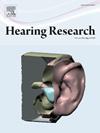哺乳动物的TMC1或tmc2对于听觉毛细胞的超燃酶活性是必需的
IF 2.5
2区 医学
Q1 AUDIOLOGY & SPEECH-LANGUAGE PATHOLOGY
引用次数: 0
摘要
听觉毛细胞中的感觉转导打开机械敏感离子通道,将声音信息转换为电信号(Zheng and Holt, 2021)。先前,我们发现跨膜通道(TMC)蛋白1和2形成毛细胞转导通道的孔(Pan et al., 2013;2018)。秀丽隐杆线虫TMC蛋白的结构(Jeong et al., 2022;Clark et al., 2024)并预测了哺乳动物TMC结构(Hahn et al., 2009;Ballesteros et al., 2018;Pan等人,2018)让人想起TMEM16蛋白,其功能是Ca2+激活的离子通道和脂质超燃酶。在这里,我们研究了TMC1药物或遗传破坏的活听性毛细胞中的脂质超燃酶活性,扩展了Ballesteros和Swartz(2022)报道的工作。我们用annexin-V标记定位于毛细胞立体纤毛膜外小叶的磷脂酰丝氨酸(PS)。PS外化是由阻断剂苯甲胺破坏感觉转导或影响TMC1渗透特性的基因突变触发的。我们发现TMC1或TMC2的表达对于PS外化至关重要。Tmc1/Tmc2敲除小鼠和Tmie突变小鼠完全缺乏PS外化。我们还确定外源性人TMCs (hTMC1或hTMC2)在Tmc1/Tmc2敲除小鼠中的表达诱导PS外化。最后,我们证明了Tmc1显性突变的表达诱发了组成型PS外化,而隐性突变则消除了PS外化。我们的数据表明,感觉传导的破坏可能导致毛细胞膜稳态失调,从而可能导致小鼠和人类的听觉功能障碍。本文章由计算机程序翻译,如有差异,请以英文原文为准。
Mammalian TMC1 or 2 are necessary for scramblase activity in auditory hair cells
Sensory transduction in auditory hair cells gates mechanosensitive ion channels, converting sound information into electrical signals (Zheng and Holt, 2021). Previously, we found that Transmembrane channel (TMC) proteins 1 and 2 form the pore of hair cell transduction channels (Pan et al., 2013; 2018). The structure of C. elegans TMC proteins (Jeong et al., 2022; Clark et al., 2024) and predicted mammalian TMC structures (Hahn et al., 2009; Ballesteros et al., 2018; Pan et al., 2018) are reminiscent of TMEM16 proteins, which function as Ca2+-activated ion channels and lipid scramblases. Here, we investigated lipid scramblase activity in live auditory hair cells with pharmacologic or genetic disruption of TMC1, extending work reported by Ballesteros and Swartz (2022). We used annexin-V to label phosphatidylserine (PS) localized in the outer leaflet of hair cell stereocilia membranes. PS externalization was triggered by disruption of sensory transduction using the blocker, benzamil, or by genetic mutations that affect TMC1 permeation properties. We found that expression of either TMC1 or TMC2, was essential for PS externalization. Tmc1/Tmc2 knockout mice and Tmie mutant mice lacked PS externalization completely. We also determined that expression of exogenous human TMCs (hTMC1 or hTMC2) in Tmc1/Tmc2 knockout mice induced PS externalization. Lastly, we demonstrated that expression of a dominant mutation in Tmc1 evoked constitutive PS externalization, while a recessive mutation eliminated PS externalization. Our data suggest that disruption of sensory transduction may lead to dysregulation of membrane homeostasis in hair cells and thus may contribute to auditory dysfunction in mice and humans.
求助全文
通过发布文献求助,成功后即可免费获取论文全文。
去求助
来源期刊

Hearing Research
医学-耳鼻喉科学
CiteScore
5.30
自引率
14.30%
发文量
163
审稿时长
75 days
期刊介绍:
The aim of the journal is to provide a forum for papers concerned with basic peripheral and central auditory mechanisms. Emphasis is on experimental and clinical studies, but theoretical and methodological papers will also be considered. The journal publishes original research papers, review and mini- review articles, rapid communications, method/protocol and perspective articles.
Papers submitted should deal with auditory anatomy, physiology, psychophysics, imaging, modeling and behavioural studies in animals and humans, as well as hearing aids and cochlear implants. Papers dealing with the vestibular system are also considered for publication. Papers on comparative aspects of hearing and on effects of drugs and environmental contaminants on hearing function will also be considered. Clinical papers will be accepted when they contribute to the understanding of normal and pathological hearing functions.
 求助内容:
求助内容: 应助结果提醒方式:
应助结果提醒方式:


